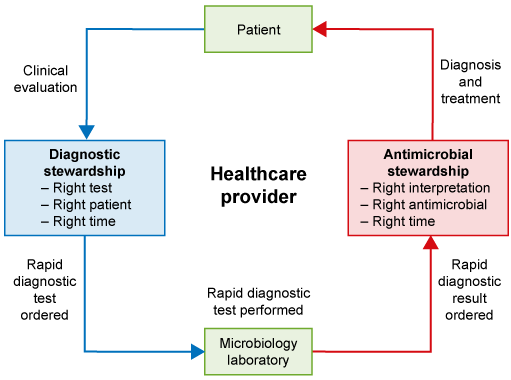4.3.1 What is diagnostic stewardship?
Diagnostic stewardship is a concept borne out of human medicine. Approaches to diagnostic stewardship are different in animal health, where antimicrobials are used for different purposes and access to laboratory services are limited and expensive.
You can find out about diagnostic stewardship in human health in the module V Diagnostic stewardship in clinical practice. Also, the WHO has published a guidance document on diagnostic stewardship, which you can read on the WHO website [Tip: hold Ctrl and click a link to open it in a new tab. (Hide tip)] at some point in the future.
The WHO defines diagnostic stewardship as:
‘The coordinated guidance and interventions to improve appropriate use of microbiological diagnostics to guide therapeutic decisions. It should promote appropriate, timely diagnostic testing, including specimen collection, and pathogen identification and accurate, timely reporting of results to guide patient treatment.’
(WHO, 2015b)
The difference between AMS and diagnostic stewardship can be seen in Figure 10. While AMS is about using the right drug at the right time at the right dose for the right duration, diagnostic stewardship is about obtaining the right test in the right patient to ensure the use of the right drug at the right time at the right dose for the right duration.

Figure 10 Roles of diagnostic and antimicrobial stewardship in the implementation of rapid molecular infectious disease diagnostics in the clinical setting (Messacar et al., 2017)
Show description|Hide descriptionAn infographic of texts boxes which show the difference between ‘Antimicrobial stewardship’ and ‘Diagnostic stewardship’. The text boxes are linked with labelled arrows that circulate around the central text ‘Healthcare provider’. The ‘Diagnostic stewardship’ arm of the graphic shows that the patient undergoes a clinical evaluation which leads to ordering the right test to be performed at a laboratory at the right time, thus facilitating rapid and tailored treatment. The ‘Antimicrobial stewardship’ arm of the graphic shows that this approach includes obtaining diagnostic tests that ensure that the right diagnosis and right treatments are brought to bear at the right time for the right duration. The two ‘stewardships’ have complementary roles in the identification and treatment of disease in animals that help stop infections spreading.




